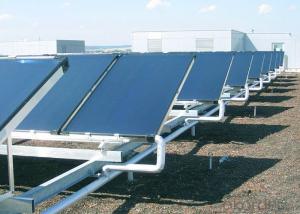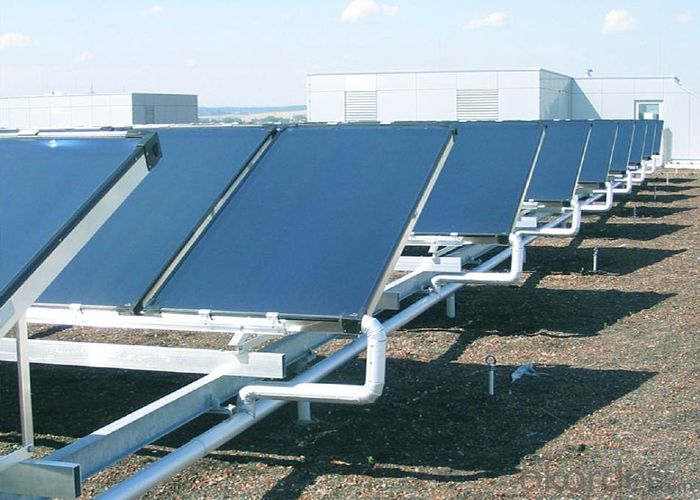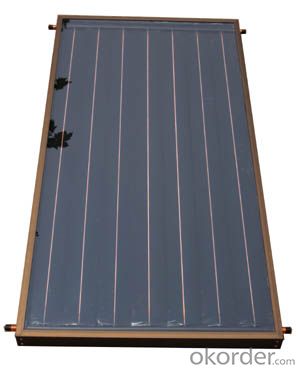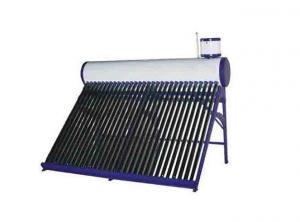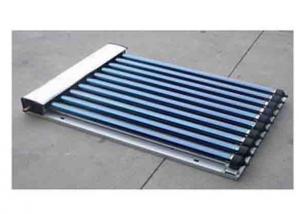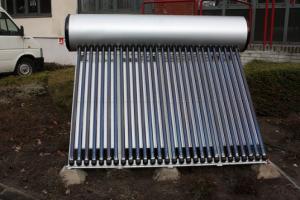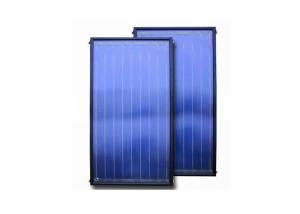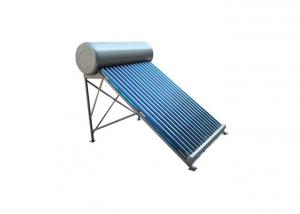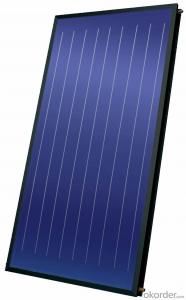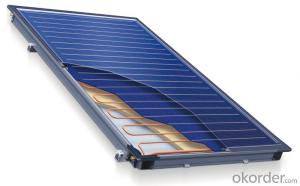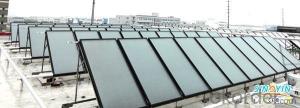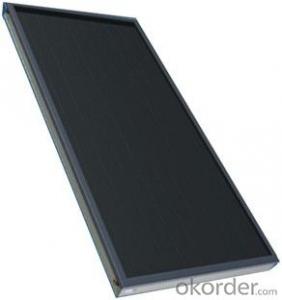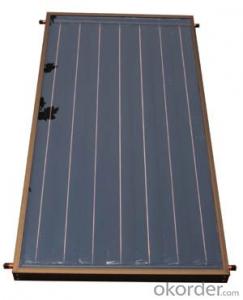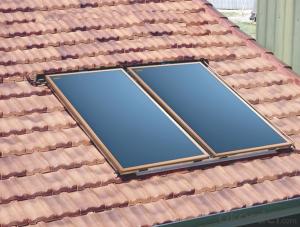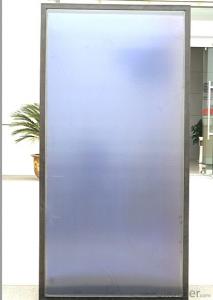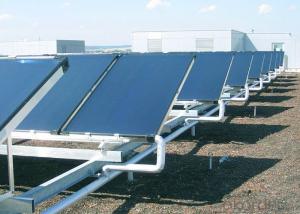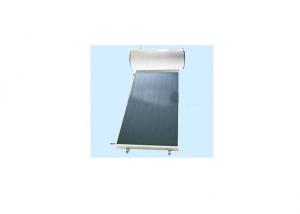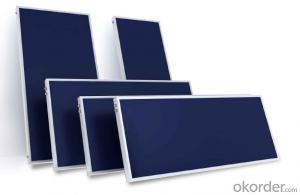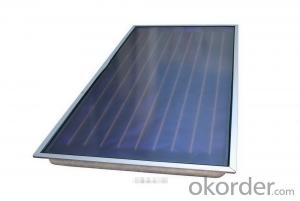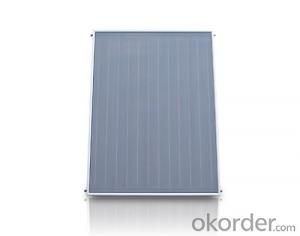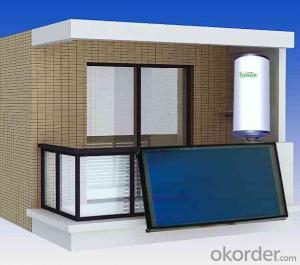Solar Collectors Blue Titanium Flat Panel Solar Thermal Collector
- Loading Port:
- Shanghai
- Payment Terms:
- TT OR LC
- Min Order Qty:
- 500 pc
- Supply Capability:
- 10000 pc/month
OKorder Service Pledge
OKorder Financial Service
You Might Also Like
Solar Thermal Collector
"This kind of products use All-glass Evacuated Tubular Solar Collector Tube with Heat Pipe as its heat-absorb element. So it can be connected to the pressurized system.
These top-of-the-range solar panel heat collectors are suitable for heating domestic hot water, swimming pools etc - even in winter! One unit is adequate for an average household (3-4people), and it is modular, so you can add more if required. A single panel is sufficient for a 200litre cylinder, but you can fit 2 or more for high water usage, or for heating swimming pools or underfloor heating. Some types of renewable energy are only available in certain locations, however free solar heating is potentially available to almost every house in the world! "
Specifications
Flat Panel Solar Collector for Solar Water Heateing
1.Certificate:CE,ISO,CCC
2.Life time:25years
3.OEM provide
Description:
Flat-plate collector is one of common solar collectors for solar hot water heating in homes and solar space heatings. Flat plate solar collectors provide quality hot water with its new solar energy efficient flat plate design. This glazed collector includes a selective coating to maximize the solar heat absorption, weather resistant aluminium framing and interior fibreglass insulation for increased efficiency.
Features:
1. Using patent advanced coating technology with high efficiency performance
2. High strength aluminium-alloy structure with surface varnish baking
3. High visual shape, easy installation, maintenance free
4. Pressurized designing, operate with pressure up to 100degree
5. Can be combined with existing energy
1) High efficiency solar collector using heat pipe evacuated tubes
2) Able to be used in all climates
3) Reliable and efficient with twin-glass solar tubes
4) Copper heat pipes for rapid heat transfer
5) Easy plug-in installation for mounting on the roof or at ground level
6) Maintenance free
7) Suitable for mains pressure water (up to 6bar / 87psi)
8) Corrosion resistant silver brazed copper header
9) Frame material: 304 2B grade standard steel
10) Casing material: 304 BA or AB stainless steel
11) Excellent insulator in glass wool
12) Collectors may be connected in series to increase water heating capacity
13) Tubes easily replaced if broken - can be used with broken tubes
14) Ideal for commercial solar water heating applications
- Q: Can solar collectors be used to generate electricity for electric vehicles?
- Yes, solar collectors can be used to generate electricity for electric vehicles. Solar collectors, also known as solar panels, convert sunlight into electricity through the photovoltaic effect. This electricity can be used to charge the batteries of electric vehicles, providing a clean and renewable source of energy. Solar panels can be installed on the roof or other surfaces of the vehicle, or they can be set up in a stationary location to charge the vehicle's battery when parked. Solar-powered electric vehicles have the advantage of reducing greenhouse gas emissions and dependence on fossil fuels, making them an environmentally friendly transportation option. However, it is worth noting that the efficiency and range of solar-powered electric vehicles may be limited by the amount of sunlight available and the size of the solar panel system.
- Q: Can solar collectors be used for heating military installations?
- Yes, solar collectors can be used for heating military installations. Solar thermal systems can provide reliable and sustainable heat for various purposes, including heating buildings, water, and even assisting in space heating during colder climates. By harnessing solar energy, military installations can reduce their dependence on fossil fuels, lower operational costs, and contribute to a greener and more resilient energy infrastructure.
- Q: Can solar collectors be used for heating sports facilities?
- Yes, solar collectors can be used for heating sports facilities. Solar thermal systems can capture sunlight and convert it into usable heat energy, which can then be used to warm indoor spaces like sports facilities. This renewable energy source is environmentally friendly and can help reduce dependence on traditional heating methods, making it a sustainable option for heating sports facilities.
- Q: Can solar collectors be used in greenhouses?
- Yes, solar collectors can be used in greenhouses to harness solar energy for heating and powering various systems within the greenhouse.
- Q: What is the impact of shading on solar collector performance?
- Shading can significantly impact the performance of solar collectors. When a solar collector is shaded, it receives less sunlight, reducing its ability to generate electricity or heat. Shading can decrease the overall efficiency of the system, resulting in lower energy production and potentially reducing the economic viability of the installation. Therefore, it is crucial to carefully consider the shading conditions and design solar collector systems to minimize shading and maximize their efficiency and output.
- Q: Can solar collectors be used for drying toys and games?
- Solar collectors can be used for drying toys and games, as they harness the sun's energy to generate heat. This heat can be utilized to accelerate the drying process, making it an eco-friendly and efficient method.
- Q: Can solar collectors be used in carbon capture and storage?
- No, solar collectors cannot be directly used in carbon capture and storage. Solar collectors are primarily used to convert sunlight into usable energy, such as electricity or heat, and are not designed for capturing and storing carbon dioxide emissions. Carbon capture and storage technologies typically involve the use of specialized equipment and processes, such as chemical absorption or carbon capture and storage facilities, which are specifically designed for capturing, transporting, and storing carbon dioxide emissions from power plants or industrial facilities.
- Q: How are solar collectors different from solar panels?
- Solar collectors and solar panels are both used to harness the energy from the sun, but they differ in their purpose and functionality. Solar collectors are specifically designed to capture and convert thermal energy from the sun into heat. These collectors are typically used for heating water or air in residential, commercial, or industrial applications. They consist of a series of tubes or pipes that circulate a heat transfer fluid, such as water or antifreeze, which absorbs the heat from the sun and transfers it to a storage tank or directly to the desired application. Solar collectors are most commonly used in solar water heating systems or for space heating. On the other hand, solar panels, also known as photovoltaic (PV) panels, are used to convert sunlight directly into electricity. They consist of multiple solar cells made of semiconductor materials, such as silicon, which generate electricity when exposed to sunlight. Solar panels are primarily used for generating electricity in residential, commercial, and utility-scale solar power systems. They can be mounted on rooftops, integrated into building materials, or installed as ground-mounted arrays. In summary, solar collectors are designed to capture and convert solar energy into heat, while solar panels are used to directly convert sunlight into electricity. Both technologies play important roles in harnessing solar energy and are utilized in various applications to reduce dependence on traditional sources of energy and promote sustainability.
- Q: Can solar collectors be used for heating historical sites?
- Yes, solar collectors can be used for heating historical sites. Solar heating systems can be installed to provide a sustainable and efficient source of heat for historical buildings. They can be integrated seamlessly into the design of the site, preserving its aesthetic value while reducing carbon emissions and energy costs. Additionally, solar collectors are a renewable energy solution, making them an environmentally-friendly choice for heating historical sites.
- Q: Can solar collectors be used in areas with limited access to government assistance?
- Yes, solar collectors can be used in areas with limited access to government assistance. Solar energy is a decentralized and renewable resource, and the installation of solar collectors requires minimal government involvement. With the decreasing costs of solar panels and the availability of financing options, individuals and communities can invest in solar power systems independently, even in areas without significant government assistance. This allows for greater energy independence and sustainability, benefiting communities with limited access to government support.
Send your message to us
Solar Collectors Blue Titanium Flat Panel Solar Thermal Collector
- Loading Port:
- Shanghai
- Payment Terms:
- TT OR LC
- Min Order Qty:
- 500 pc
- Supply Capability:
- 10000 pc/month
OKorder Service Pledge
OKorder Financial Service
Similar products
Hot products
Hot Searches
Related keywords
